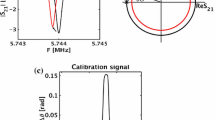Abstract
The Xilinx ZCU111 Radio Frequency System on Chip (RFSoC) is a promising solution for reading out large arrays of microwave kinetic inductance detectors (MKIDs). The board boasts eight on-chip 12-bit / 4.096 giga samples-per-second (GSPS) analogue-to-digital converters (ADCs) and eight 14-bit / 6.554 GSPS digital-to-analogue converters (DACs), as well as field programmable gate array (FPGA) resources of 930,000 logic cells and 4,272 digital signal processing (DSP) slices. While this is sufficient data converter bandwidth for the readout of 8,000 MKIDs, with a 2 MHz channel-spacing and a 1 MHz sampling rate (per channel), additional FPGA resources are required to perform the DSP needed to process this large number of MKIDs, due to a mismatch between the data converter bandwidth relative to the FPGA resources of the ZCU111. A solution to this problem is the new Xilinx RFSoC 2x2 board. This board costs only one fifth of the ZCU111 while still providing the same logic resources, albeit with only a quarter of the data converter resources. Thus, using multiple RFSoC 2x2 boards would provide a better balance between FPGA resources and data converters, allowing the full utilization of the RF bandwidth provided by the data converters, while also lowering the cost per pixel value of the readout system; from approximately €2.50 per pixel with the ZCU111 to €1 per pixel with the 2x2.




Similar content being viewed by others
Data Availability
The datasets generated during and/or analysed during the current study are available from the corresponding author on reasonable request.
References
P. Day, H. Leduc, B. Mazin, A. Vayonakis, J. Zmuidzinas, Nature 425, 817 (2003). https://doi.org/10.1038/nature02037
G. Ulbricht, M. De Lucia, E. Baldwin, Appl. Sci. 11, (2021). https://doi.org/10.3390/app11062671
K. Irwin, G. Hilton, Cryogen. Particle Detect. 99, 81 (2005)
L. Fleischmann, M. Linck, A. Burck, C. Domescle, S. Kempf, A. Pabinger, C. Pies, J. Porst, H. Rotzinger, S. Schafer, R. Weldle, A. Fleischmann, C. Enss, G. Seidel, IEEE Trans. Appl Supercond. 19, 63 (2009). https://doi.org/10.1109/TASC.2009.2012724
J. Mates, PhD Thesis (2011)
K. Irwin, Appl. Phys. Lett. 66, (1995). https://doi.org/10.1063/1.113674
M. Strader, PhD Thesis (2016)
S. McHugh, B. Mazin, B. Serfass, S. Meeker, K. O’Brien, R. Duan, R. Raffanti, D. Werthimer, Rev. Sci. Instrum. 83, (2012). https://doi.org/10.1063/1.3700812
J. Hickish, Z. Abdurashidova, Z. Ali, K. Buch, S. Chaudhari, H. Chen, M. Dexter, R. Simone Domagalski, J. Ford, G. Foster, D. George, J. Greenberg, L. Greenhill, A. Isaacson, H. Jiang, G. Jones, F. Kapp, H. Kriel, R. Lacasse, D. Werthimer, J. Astron. Instrum. 05, (2016). https://doi.org/10.1142/S2251171716410014
N. Fruitwala, P. Strader, G. Cancelo, T. Zmuda, K. Treptow, N. Wilcer, C. Stoughton, A. Walter, N. Zobrist, G. Collura, Rev. Sci. Instrum. 91, 124705 (2020). https://doi.org/10.1063/5.0029457
Xilinx Datasheet (2018)
Hitech Global Datasheet (2021)
B. Mazin, S. Meeker, M. Strader, B. Bumble, K. O’Brien, P. Szypryt, D. Marsden, J. Eyken, G. Duggan, G. Ulbricht, C. Stoughton, M. Johnson, Publ. Astron. Soc. Pac. 125, (2013). https://doi.org/10.1086/674013
S. Meeker, PhD Thesis (2017)
S. Meeker, B. Mazin, A. Walter, P. Strader, N. Fruitwala, C. Bockstiegel, P. Szypryt, G. Ulbricht, G. Coiffard, B. Bumble, G. Cancelo, T. Zmuda, K. Treptow, N. Wilcer, G. Collura, R. Dodkins, I. Lipartito, N. Zobrist, M. Bottom, J. Chris Shelton, D. Mawet, J. van Eyken, G. Vasisht, E. Serabyn, Publ. Astron. Soc. Pac. 130, (2018). https://doi.org/10.1088/1538-3873/aab5e7
Xilinx, FIR Compiler v7.2 LogiCORE IP Product Guide (2021)
Xilinx, Fast Fourier Transform v9.1 LogiCORE IP Product Guide (2021)
J.W. Cooley, J.W. Tuckey, Math. Comput. 19, (1965). https://doi.org/10.1090/S0025-5718-1965-0178586-1
R. Martin, Bit by Bit Signal Processing, Bit-by-Bit’s “BxBFFT” Fast Fourier Transform
H. Okean, A. Kelly, IEEE Trans. Microw. Theory Tech. 25, (1977). https://doi.org/10.1109/TMTT.1977.1129089
Acknowledgements
This material is based upon works supported by the Science Foundation Ireland under Grant No. grant 15/IA/2880. The authors would also like to thank Dr Deli Geng from Durham University for providing the mixer board which was used to help generate the data for Figs. 3 and 4. Furthermore, the authors would like to thank Cathal McCabe of Xilinx for providing the Vivado licenses used in the project.
Author information
Authors and Affiliations
Corresponding author
Additional information
Publisher's Note
Springer Nature remains neutral with regard to jurisdictional claims in published maps and institutional affiliations.
Rights and permissions
Springer Nature or its licensor holds exclusive rights to this article under a publishing agreement with the author(s) or other rightsholder(s); author self-archiving of the accepted manuscript version of this article is solely governed by the terms of such publishing agreement and applicable law.
About this article
Cite this article
Baldwin, E., De Lucia, M., Bracken, C. et al. Frequency Domain Multiplexing for Microwave Kinetic Inductance Detectors: Comparing the Xilinx ZCU111 RFSoC with the New 2x2 RFSoC Board. J Low Temp Phys 209, 640–648 (2022). https://doi.org/10.1007/s10909-022-02785-x
Received:
Accepted:
Published:
Issue Date:
DOI: https://doi.org/10.1007/s10909-022-02785-x




